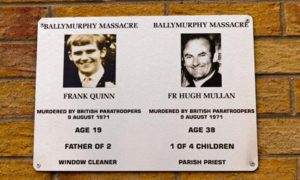Mentre si sta per avviare una nuova inchiesta sul massacro del 1971, gli attivisti dicono di avere testimoni che contrastano la versione dell’esercito

I parenti e gli attivisti delle 10 persone uccise dal Reggimento Paracadutisti sette mesi prima della Bloody Sunday hanno scoperto le testimonianze dei soldati che mettono un punto di domanda alla versione ufficiale dell’esercito britannico.
L’esercito ha sembra ribadito che le truppe avevano aperto il fuoco dopo essere state attaccate con armi da fuoco e bottiglie molotov. Ma le famiglie delle vittime hanno sempre parlato di innocenza dei loro cari.
Il procuratore generale nordirlandese ha ordinato l’apertura di 10 inchieste. Per le famiglie di Ballymurphy la decisione di John Larkin è un passo importante verso la giustizia.
John Teggart, il cui padre fu ucciso dai paracadutisti, afferma che la decisione di Larkin è “un’altra pietra miliare sulla strada verso una completa inchiesta internazionale sul massacro”.
Durante la campagna di sensibilizzazione, spiega Teggart, abbiamo ricevuto le testimonianze delle truppe, redatte in seguito dal ministero della Difesa. “Le dichiarazioni originali mostrano, tra le altre cose, che una delle vittime era stata colpita da circa 30 proiettili. Siamo lieti delle nuove inchieste perché quelle originali erano datate 1972”, prosegue Teggart.
Le famiglie hanno portato avanti un’incessante campagna per chiedere un’inchiesta indipendente sul massacro. Secondo loro l’inchiesta deve esplorare la possibilità che alcuni dei soldati responsabili di aver colpito i loro cari a Belfast fossero parte della stessa unità che uccise 14 persone durante la Bloody Sunday di Derry.
Gli attivisti di Ballymurphy puntano il dito sulla dichiarazione del Soldato A, che davanti alla Saville Inquiry affermò di essere stato impegnato a Ballymurphy nel 1972, prima di operare durante la Bloody Sunday.
Dieci persone furono uccise durante l’operazione dell’esercito ed un altro uomo morì in quello che le famiglie ritengono un incidente collegato. Durante il massacro le truppe sono accusate di aver sparato contro il corteo funebre di un uomo annegato accidentalmente qualche giorno prima nei pressi del quartiere. Si sostiene inoltre che i lealisti dell’Ulster Volunteer Force si unirono nel combattere dalla parte dell’esercito, sparando sulla zona nazionalista dal vicino quartiere protestante di Springmartin.
Il Northern Ireland Office ha escluso qualsiasi inchiesta pubblica sulle uccisioni, che sarebbe simile al tribunale istituito per la Bloody Sunday. Le famiglie dicono che un’inchiesta internazionale non sarebbe durata più a lungo né sarebbe stata così costosa quando la multimilionaria Bloody Sunday Inquiry, la più lunga della storia legale britannica.
Tratto da The Guardian
Ballymurphy families claim soldiers admitted to firing on civilians
As fresh inquests are ordered into 1971 killings, activists say they have testimony that challenges army’s version of events
Relatives and campaigners for 10 people the Parachute Regiment killed seven months before the 1972 Bloody Sunday killings said they had uncovered soldiers’ testimony that called into question the army’s official version.
The military has always maintained the troops opened fire after coming under attack with gunfire and petrol bombs in the Ballymurphy estate in August 1971. But families of the dead, who included a mother of eight and a Catholic, have maintained their loved ones’ innocence.
Northern Ireland’s attorney general ordered on Tuesday that 10 new inquests must be held in connection with the army shootings. Families of the victims said the decision by John Larkin was an important step to obtain justice.
John Teggart, whose father was shot dead by the paratroopers, said the Larkin’s decision was “yet another milestone on the road to a full international inquiry into the massacre”.
He said in the course of their campaign they received statements from the troops, which were later redacted by the Ministry of Defence. “The original statements show among other things that one victim was hit with 30 rounds. We are delighted that there will be new inquests as the original ones were flawed back in 1972,” Teggart said.
The families have carried out a long-running campaign for an independent inquiry into the killings. They have called for any inquiry to explore the possibility that some of the soldiers responsible for firing on their loved ones in Belfast were part of the same unit that later carried out the Bloody Sunday killings in Derry.
The Ballymurphy campaigners point to the evidence of Soldier A, who during testimony to the Saville inquiry said that prior to Bloody Sunday he had been in Ballymurphy around August 1971 on deployment.
Ten people were shot dead during the shootings and another man died from what the families claim was a related incident. During the killings troops are alleged to have fired on the funeral party of a man who had accidentally drowned a few days earlier near the district. It is also alleged that members of the loyalist Ulster Volunteer Force joined in the fighting on the side of the army, firing on the nationalist area from the nearby Protestant Springmartin housing estate.
The Northern Ireland Office has ruled out any public inquiry into the killings, which would be similar to the Bloody Sunday tribunal. The families say an international-based inquiry would not last as long or be as costly as the multimillion-pound Bloody Sunday inquiry, which was the longest in British legal history.